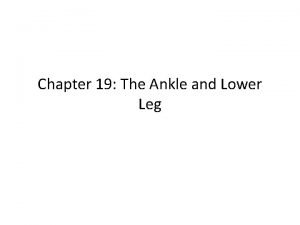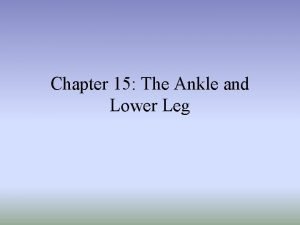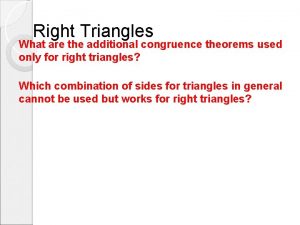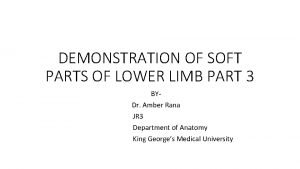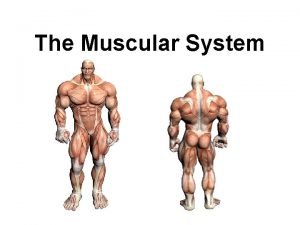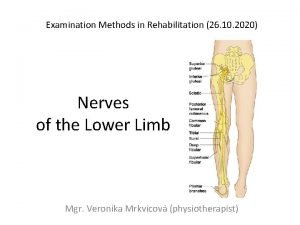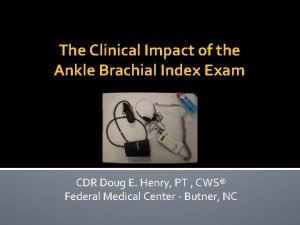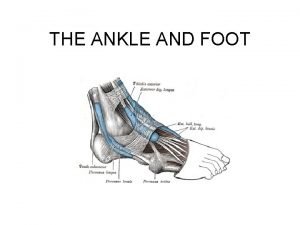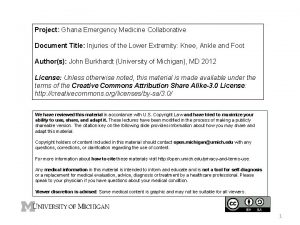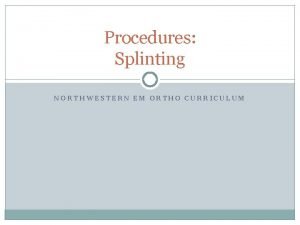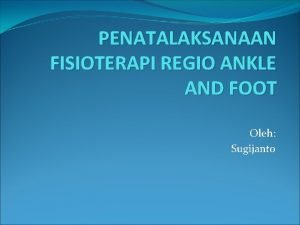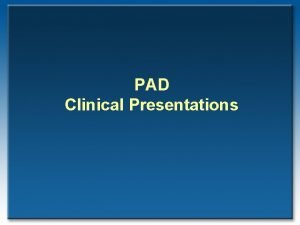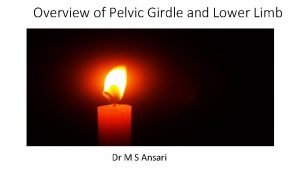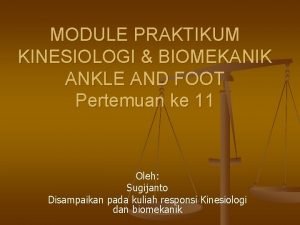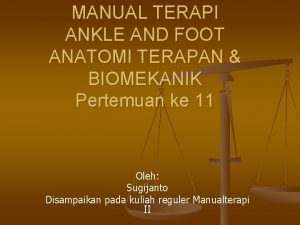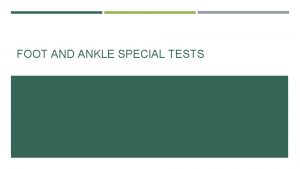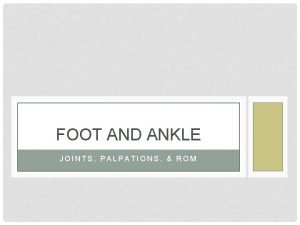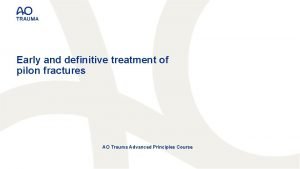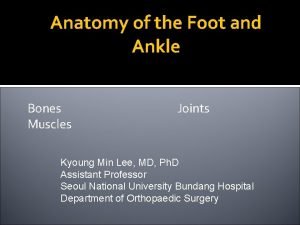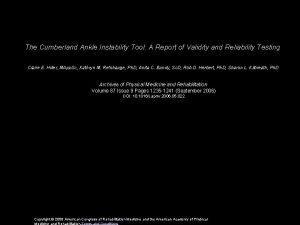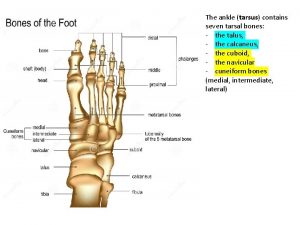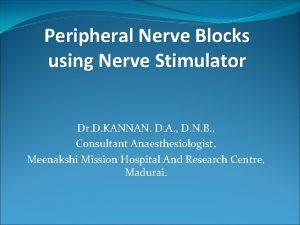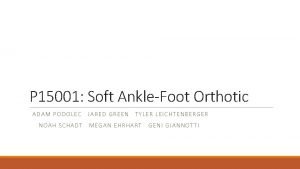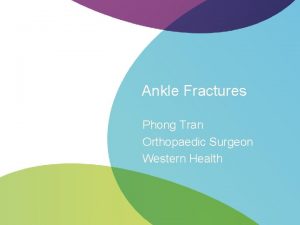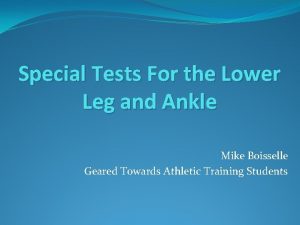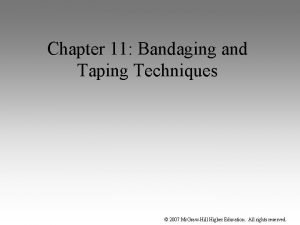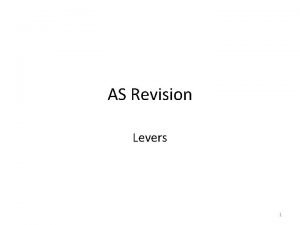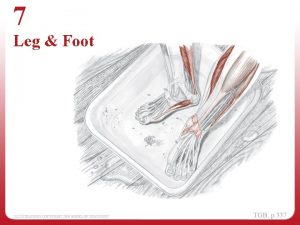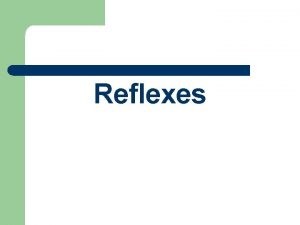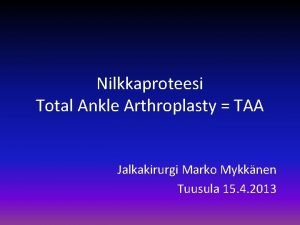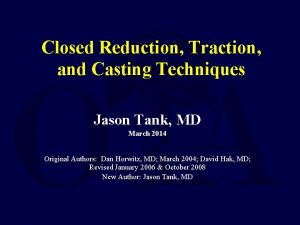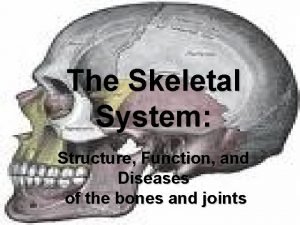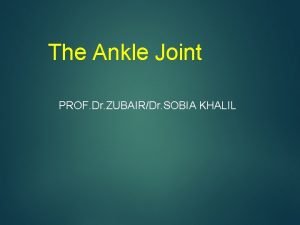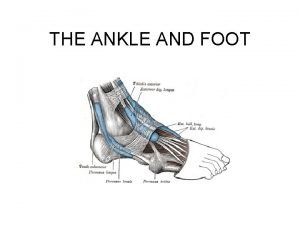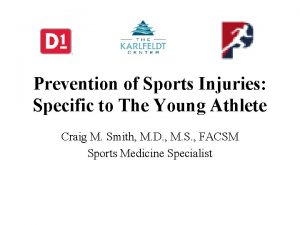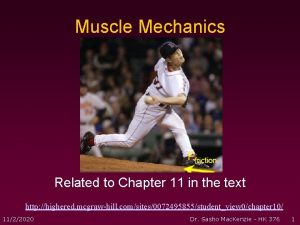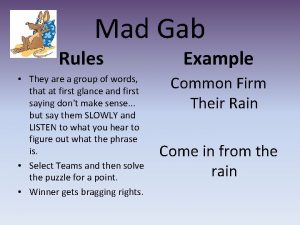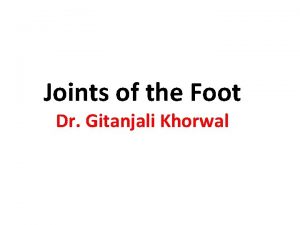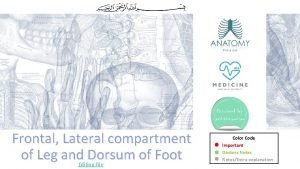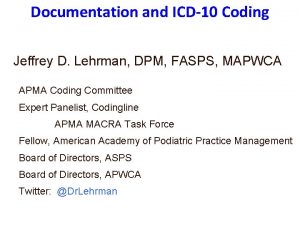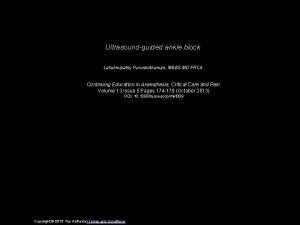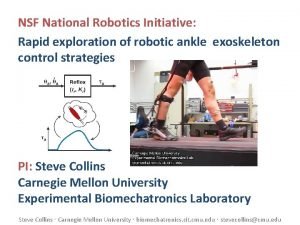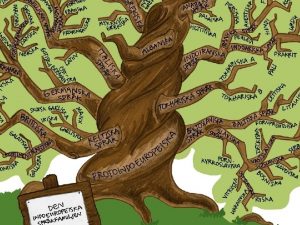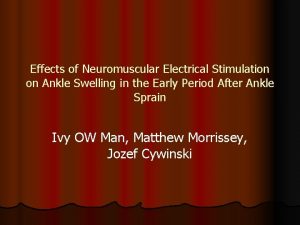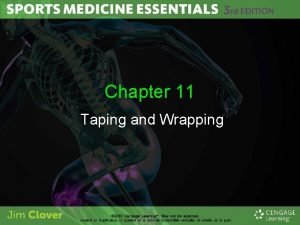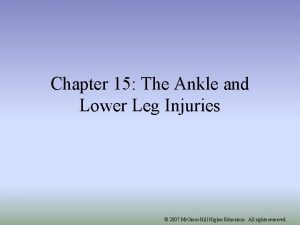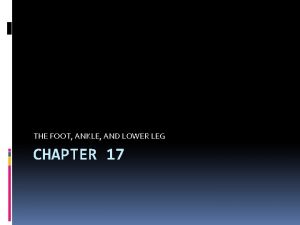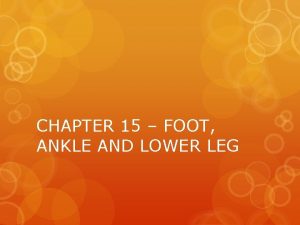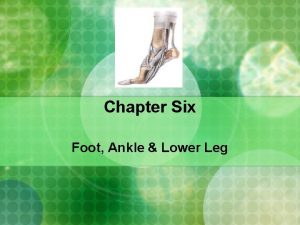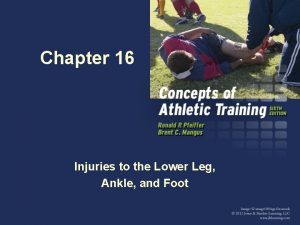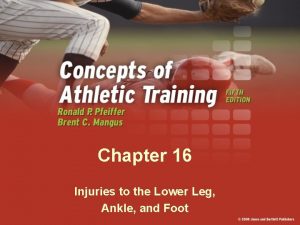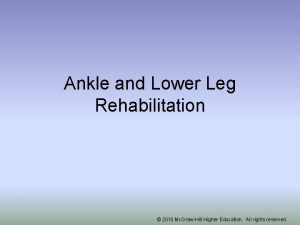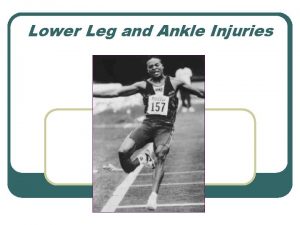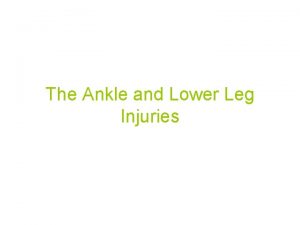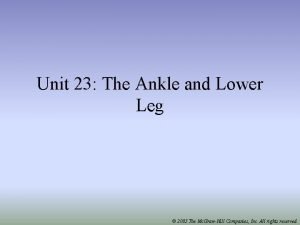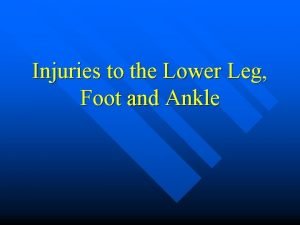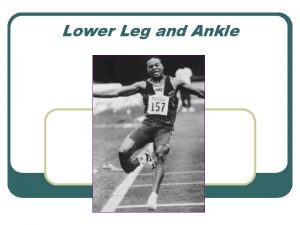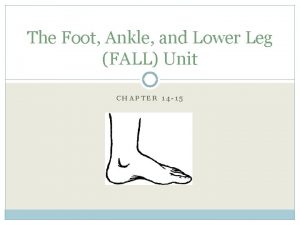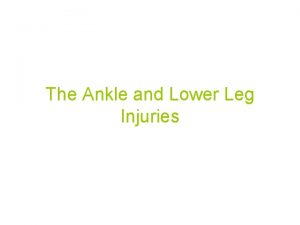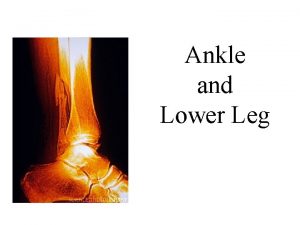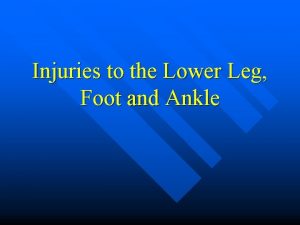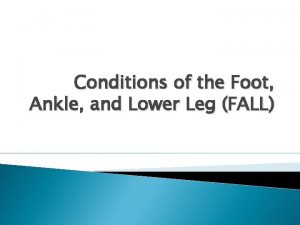Chapter 19 The Ankle and Lower Leg 2011











































































- Slides: 75

Chapter 19: The Ankle and Lower Leg © 2011 Mc. Graw-Hill Higher Education. All rights reserved.

Figure 19 -1 © 2011 Mc. Graw-Hill Higher Education. All rights reserved.

Figure 19 -2 © 2011 Mc. Graw-Hill Higher Education. All rights reserved.

Figure 19 -3 © 2011 Mc. Graw-Hill Higher Education. All rights reserved.

Figure 19 -4 © 2011 Mc. Graw-Hill Higher Education. All rights reserved.

Figure 19 -5 © 2011 Mc. Graw-Hill Higher Education. All rights reserved.

© 2011 Mc. Graw-Hill Higher Education. All rights reserved.

Figure 19 -6 © 2011 Mc. Graw-Hill Higher Education. All rights reserved.

Figure 19 -8 © 2011 Mc. Graw-Hill Higher Education. All rights reserved.

Functional Anatomy • Ankle is a stable hinge joint • Medial and lateral displacement is prevented by the malleoli • Ligament arrangement limits inversion and eversion at the subtalar joint • Square shape of talus adds to stability of the ankle • Most stable during dorsiflexion, least stable in plantar flexion © 2011 Mc. Graw-Hill Higher Education. All rights reserved.

• Degrees of motion for the ankle range from 10 degrees of dorsiflexion to 50 degrees of plantar flexion • Normal gait requires 10 degrees of dorsiflexion and 20 degrees of plantar flexion with the knee fully extended • Normal ankle function is dependent on action of the rear foot and subtalar joint • Critical link in kinetic chain © 2011 Mc. Graw-Hill Higher Education. All rights reserved.

Preventing Injury in the Lower Leg and Ankle • Achilles Tendon Stretching – A tight heel cord may limit dorsiflexion and may predispose individual to ankle injury – Should routinely stretch before and after practice – Stretching should be performed with knee extended and flexed 15 -30 degrees • Strength Training – Static and dynamic joint stability is critical in preventing injury – While maintaining normal ROM, muscles and tendons surrounding joint must be kept strong © 2011 Mc. Graw-Hill Higher Education. All rights reserved.

• Neuromuscular Control Training – Can be enhanced by training in controlled activities – Uneven surfaces, BAPS boards, rocker boards, or Dynadiscs can also be utilized to challenge athlete Figure 19 -39 © 2011 Mc. Graw-Hill Higher Education. All rights reserved.

• Footwear – Can be an important factor in reducing injury – Shoes should not be used in activities they were not made for • Preventive Taping and Orthoses – Tape can provide some prophylactic protection – Improperly applied tape can disrupt normal biomechanical function and cause injury – Lace-up braces have even been found to be superior to taping relative to prevention © 2011 Mc. Graw-Hill Higher Education. All rights reserved.

Assessing the Lower Leg and Ankle • History – Past history – Mechanism of injury – When does it hurt? – Type of, quality of, duration of pain? – Sounds or feelings? – How long were you disabled? – Swelling? – Previous treatments? © 2011 Mc. Graw-Hill Higher Education. All rights reserved.

• Observations – Postural deviations? – Genu valgum or varum? – Is there difficulty with walking? – Deformities, asymmetries or swelling? – Color and texture of skin, heat, redness? – Patient in obvious pain? – Is range of motion normal? Figure 19 -9 © 2011 Mc. Graw-Hill Higher Education. All rights reserved.

• Palpation: Bones and Soft Tissue • Fibular head and shaft • Lateral malleolus • Tibial plateau • Tibial shaft • Medial malleolus • Dome of talus • Calcaneus • Sustentaculum tali • • Peroneus longus Peroneus brevis Peroneus tertius Flexor digitorum longus • Flexor hallucis • Posterior tibialis © 2011 Mc. Graw-Hill Higher Education. All rights reserved.

• Palpation: Soft Tissue (continued) • Anterior tibialis • Extensor hallucis longus • Extensor digitorum longus • Gastrocnemius • Soleus • Achilles tendon • Anterior/posterior talofibular ligament • Calcaneofibular ligament • Deltoid ligament • Anterior tibiofibular ligament • Posterior tibiofibular ligament © 2011 Mc. Graw-Hill Higher Education. All rights reserved.

• Special Test - Lower Leg – Lower Leg Alignment Tests • Mal-alignment can reveal causes of abnormal stresses applied to foot, ankle, lower leg, knees and hips • Anteriorly, a straight line can be drawn from ASIS, through patella and between 1 st and 2 nd toes • Laterally, a straight line can go from greater trochanter through center of patella and just behind the lateral malleolus • Posteriorly, a line can be drawn through the center of the lower leg, midline to the Achilles and calcaneus • Internal or external tibial torsion is also a common mal-alignment © 2011 Mc. Graw-Hill Higher Education. All rights reserved.

– Percussion and compression tests for fracture • Percussion test is a blow to the tibia, fibula or heel to create vibratory force that resonates w/in fracture • Compression test involves compression of tibia and fibula either above or below site of concern • Tuning forks can also be used to create vibration at point of injury – Thompson test • Squeeze calf muscle, while foot is extended off table to test the integrity of the Achilles tendon – Positive tests results in no movement in the foot – Homan’s test • Test for deep vein thrombophlebitis • With knee extended and foot off table, ankle is moved into dorsiflexion • Pain in calf is a positive sign and should be referred © 2011 Mc. Graw-Hill Higher Education. All rights reserved.

Compression Test Homan’s Test Percussion Test Thompson Test © 2011 Mc. Graw-Hill Higher Education. All rights reserved.

• Ankle Stability Tests – Anterior drawer test • Used to determine damage to anterior talofibular ligament primarily and other lateral ligament secondarily • A positive test occurs when foot slides forward and/or makes a clunking sound as it reaches the end point – Talar tilt test • Performed to determine extent of inversion or eversion injuries • With foot at 90 degrees calcaneus is inverted and excessive motion indicates injury to calcaneofibular ligament and possibly the anterior and posterior talofibular ligaments • If the calcaneus is everted, the deltoid ligament is tested © 2011 Mc. Graw-Hill Higher Education. All rights reserved.

Anterior Drawer Test Talar Tilt Test Figures 19 -14 & 15 © 2011 Mc. Graw-Hill Higher Education. All rights reserved.

– Kleiger’s test • Used primarily to determine extent of damage to the deltoid ligament and may be used to evaluate distal ankle syndesmosis, anterior/posterior tibiofibular ligaments and the interosseus membrane • With lower leg stabilized, foot is rotated laterally to stress the deltoid – Medial Subtalar Glide Test • Performed to determine presence of excessive medial translation of the calcaneus on the talus • Talus is stabilized in subtalar neutral, while other hand glides the calcaneus, medially • A positive test presents with excessive movement, indicating injury to the lateral ligaments © 2011 Mc. Graw-Hill Higher Education. All rights reserved.

Kleiger’s Test Medial Subtalar Glide Test Figures 19 -16 & 17 © 2011 Mc. Graw-Hill Higher Education. All rights reserved.

• Functional Tests – While weight bearing the following should be performed • • • Walk on toes (plantar flexion) Walk on heels (dorsiflexion) Walk on lateral borders of feet (inversion) Walk on medial borders of feet (eversion) Hops on injured ankle Passive, active and resistive movements should be manually applied to determine joint integrity and muscle function – If the patient has difficulty with bearing weight these tests should not be utilized. © 2011 Mc. Graw-Hill Higher Education. All rights reserved.

Specific Injuries • Ankle Injuries: Sprains – Single most common injury in the physically active caused by sudden inversion or eversion moments • Inversion Sprains – Most common and result in injury to the lateral ligaments – Anterior talofibular ligament is injured with inversion, plantar flexion and internal rotation – Occasionally the force is great enough for an avulsion fracture to occur w/ the lateral malleolus © 2011 Mc. Graw-Hill Higher Education. All rights reserved.

• Severity of ligament sprains is classified according to grades • With inversion sprains the foot is forcefully inverted or occurs when the foot comes into contact w/ uneven surfaces Figure 19 -19 © 2011 Mc. Graw-Hill Higher Education. All rights reserved.

• Ottawa Ankle Rules – Used for determining need for radiograph – Most often used in emergency room – Indicates that Figure 19 -21 • 1. Required if pain in malleolar or midfoot area • Inability to bear weight for 4 steps (2 on each foot) at time of injury and examination • Tenderness over inferior or posterior pole of either malleoli • Inability to bear weight (4 steps taken independently, even if limping) at time of injury and/or evaluation • Tenderness along base of 5 th metatarsal or navicular bone – The Buffalo modification focuses on tenderness along fibula © 2011 Mc. Graw-Hill Higher Education. All rights reserved.

• Grade 1 Ligament Sprain – Etiology • Occurs with inversion plantar flexion and adduction • Causes stretching of the anterior talofibular ligament – Signs and Symptoms • Mild pain and disability; weight bearing is minimally impaired; point tenderness over ligaments and no laxity – Management • RICE for 1 -2 days; limited weight bearing initially and then aggressive rehab • Tape may provide some additional support • Return to activity in 7 -10 days © 2011 Mc. Graw-Hill Higher Education. All rights reserved.

• Grade 2 Ligament Sprain – Etiology • Moderate inversion force causing great deal of disability with many days of lost time – Signs and Symptoms • Feel or hear pop or snap; moderate pain w/ difficulty bearing weight; tenderness and edema • Positive talar tilt and anterior drawer tests – Management • RICE for at least first 72 hours; X-ray exam to rule out fx; crutches 5 -10 days, progressing to weight bearing © 2011 Mc. Graw-Hill Higher Education. All rights reserved.

– Management (continued) • Will require protective immobilization but begin ROM exercises early to aid in maintenance of motion and proprioception • Taping will provide support during early stages of walking and running • Long term disability will include chronic instability with injury recurrence potentially leading to joint degeneration • Must continue to engage in rehab to prevent against re-injury © 2011 Mc. Graw-Hill Higher Education. All rights reserved.

• Grade 3 Ligament Sprain – Etiology • Relatively uncommon but is extremely disabling • Caused by significant force (inversion) resulting in spontaneous subluxation and reduction • Causes damage to the anterior/posterior talofibular and calcaneofibular ligaments as well as the capsule – Signs and Symptoms • Severe pain, swelling, hemarthrosis, discoloration • Unable to bear weight • Positive talar tilt and anterior drawer © 2011 Mc. Graw-Hill Higher Education. All rights reserved.

– Management • RICE, X-ray (physician may apply dorsiflexion splint for 3 -6 weeks) • Crutches are provided after cast removal • Isometrics in cast; ROM, PRE and balance exercise once out • Surgery may be warranted to stabilize ankle due to increased laxity and instability © 2011 Mc. Graw-Hill Higher Education. All rights reserved.

• Eversion Ankle Sprains -(Represent 5 -10% of all ankle sprains) • Etiology – Bony protection and ligament strength decreases likelihood of injury – Eversion force results in damage to deltoid ligament and possibly fx of the fibula – Deltoid can also be impinged and contused with inversion sprains Figure 19 -24 A & B © 2011 Mc. Graw-Hill Higher Education. All rights reserved.

– Etiology (continued) • Due to severity of injury, it may take longer to heal • Foot that is pronated, hypermobile or has a depressed medial longitudinal arch is more predisposed to eversion sprains – Signs and Symptoms • Pain may be severe; unable to bear weight; and pain with abduction and adduction but not direct pressure on bottom of foot – Management • RICE; X-ray to rule out fx; no weight bearing initially; posterior splint tape; NSAID’s • Follows the same course of treatment as inversion sprains • Grade 2 or higher will present with considerable instability and may cause weakness in medial longitudinal arch resulting in excessive pronation or fallen arch © 2011 Mc. Graw-Hill Higher Education. All rights reserved.

• Syndesmotic Sprain – Etiology • Injury to the distal tibiofemoral joint (anterior/posterior tibiofibular ligament) • Torn w/ increased external rotation or dorsiflexion • Injured in conjunction w/ medial and lateral ligaments – Signs and Symptoms • Severe pain, loss of function; passive external rotation and dorsiflexion cause pain • Pain is usually anterolaterally located – Management • Difficult to treat and may requires months of treatment • Same course of treatment as other sprains, however, immobilization and total rehab may be longer • Surgery may be required © 2011 Mc. Graw-Hill Higher Education. All rights reserved.

• Ankle Fractures/Dislocations – Etiology • Number of mechanisms – Avulsion, bi-malleolar fractures – Signs and Symptoms • Swelling and pain may be extreme with possible deformity – Management • RICE to control hemorrhaging and swelling • Once swelling is reduced, a walking cast or brace may be applied, w/ immobilization lasting 6 -8 weeks © 2011 Mc. Graw-Hill Higher Education. All rights reserved.

Figure 19 -26 © 2011 Mc. Graw-Hill Higher Education. All rights reserved.

Figure 19 -26 B © 2011 Mc. Graw-Hill Higher Education. All rights reserved.

• Osteochondritis Dissecans – Etiology • Occur in superior medial articular surface of the talar dome • One or several fragments of articular cartilage, w/ underlying subchondral bone partially or completely detached and moving within the joint space • Mechanism may be single trauma or repeated traumas – Signs and Symptoms • May be a complaint of pain and effusion with signs of atrophy • May also be catching, locking, or giving way © 2011 Mc. Graw-Hill Higher Education. All rights reserved.

• Osteochondritis Dissecans – Management • Diagnosis through X-ray or MRI • Incomplete and non-displaced injuries can be immobilized with early motion and delayed weight bearing • If fragments are displaced, surgery is necessary • Surgery will minimize risk of nonunion © 2011 Mc. Graw-Hill Higher Education. All rights reserved.

• Acute Achilles Strain – Etiology • Common in sports and often occurs with sprains or excessive dorsiflexion – Sign and Symptoms • Pain may be mild to severe • Most severe injury is partial/complete avulsion or rupturing of the Achilles – Management • Pressure and RICE should be applied • After hemorrhaging has subsided an elastic wrap should continue to be applied • Conservative treatment should be used as Achilles problems generally become chronic • A heel lift should be used and stretching and strengthening should begin soon © 2011 Mc. Graw-Hill Higher Education. All rights reserved.

• Achilles Tendinosis – Etiology • Achilles tendinitis is an inflammatory condition involving tendon, sheath or paratenon – Referred to as tenosynovitis – Causes fibrosis and scaring that can restrict tendon motion in sheath – May lead to tendinosis • Achilles tendinosis typically does not present with inflammation, area has lost normal appearance, with cell disorganization/scarring and degeneration • Tendon is overloaded due to extensive stress • Presents with gradual onset and worsens with continued use • Decreased flexibility exacerbates condition © 2011 Mc. Graw-Hill Higher Education. All rights reserved.

– Signs and Symptoms • Generalized pain and stiffness, localized proximal to calcaneal insertion • Warm and painful with palpation, also presents with thickening • May limit strength • May progress to morning stiffness • Crepitus with active plantar flexion and passive dorsiflexion • Chronic inflammation may lead to thickening Figure 19 -27 © 2011 Mc. Graw-Hill Higher Education. All rights reserved.

– Management • Resistant to quick resolution due to slow healing nature of tendon • Must reduce stress on tendon, address structural faults (orthotics, mechanics, flexibility) • Use anti-inflammatory modalities and medications • Cross friction massage may be helpful in breaking down adhesions • Strengthening must progress slowly in order to not aggravate the tendon © 2011 Mc. Graw-Hill Higher Education. All rights reserved.

• Achilles Tendon Rupture – Etiology • Occurs w/ sudden stop and go; forceful plantar flexion w/ knee moving into full extension • Commonly seen in athletes > 30 years old – Can be observed at any age • Generally has history of chronic inflammation – Signs and Symptoms • Sudden snap (kick in the leg) w/ immediate pain which rapidly subsides • Point tenderness, swelling, discoloration; decreased ROM • Obvious indentation and positive Thompson test • Occurs 2 -6 cm proximal the calcaneal insertion © 2011 Mc. Graw-Hill Higher Education. All rights reserved.

• Achilles Tendon Rupture (continued) – Management • Usual management involves surgical repair for serious injuries (return of 75 -80% of function) • Non-operative treatment consists of RICE, NSAID’s, analgesics, and a non-weight bearing cast for 6 weeks, followed up by a walking cast for 2 weeks (75 -90% return to normal function) • Rehabilitation lasts about 6 months Figure 19 -28 and consists of ROM, PRE and wearing a 2 cm heel lift in both shoes © 2011 Mc. Graw-Hill Higher Education. All rights reserved.

• Peroneal Tendon Subluxation/Dislocation – Etiology • Occurs in sports with dynamic forces being applied to the ankle • May also be caused by dramatic blow to posterior lateral malleolus, or moderate/severe inversion ankle sprain resulting in tearing of peroneal retinaculum • In some cases tendon may rupture – Signs and Symptoms • • Complain of snapping in and out of groove with activity Eversion against manual resistance replicates subluxation Recurrent pain, snapping and instability Present with ecchymosis, edema, tenderness, and crepitus over the tendon © 2011 Mc. Graw-Hill Higher Education. All rights reserved.

• Peroneal Subluxation (continued) – Management • Conservative approach should be used first, including compression with felt horseshoe • Reinforce compression pad with rigid plastic or plaster until acute signs have subsided • RICE, NSAID’s and analgesics • Conservative treatment time 5 -6 weeks followed by gradual rehab program • Surgery if conservative plan fails © 2011 Mc. Graw-Hill Higher Education. All rights reserved.

• Anterior Tibialis Tendinitis – Etiology • Commonly occurs after extensive down hill running – Signs and Symptoms • Point tenderness over anterior tibialis tendon – Management • Rest or at least decrease running time and distance, avoid hills • In more serious cases, ice & stretch before and after running to reduce symptoms • Daily strengthening should be conducted • Oral anti-inflammatory medication may be required © 2011 Mc. Graw-Hill Higher Education. All rights reserved.

• Posterior Tibialis Tendinitis – Etiology • Common overuse condition in runners with foot hypermobility or over pronation • Repetitive microtrauma – Signs and Symptoms • Pain and swelling in area of medial malleolus • Edema, point tenderness and increased pain during resistive inversion and plantar flexion – Management • Initially, RICE, NSAID’s and analgesics • Non-weight bearing cast w/ foot in inversion may be used • Correct problem of over pronation with taping or orthotic © 2011 Mc. Graw-Hill Higher Education. All rights reserved.

• Peroneal Tendinitis – Etiology • Not common, but can be found with patients that have pes cavus due to excessive supination placing stress on peroneal tendon – Signs and Symptoms • Pain behind lateral malleolus during push-off or when rising on ball of foot • Pain along distolateral aspect of calcaneus and beneath the cuboid – Management • RICE, NSAID’s, elastic taping, appropriate warm-up and flexibility exercises • Low. Dye taping or orthotics to help support foot © 2011 Mc. Graw-Hill Higher Education. All rights reserved.

Figure 19 -29 © 2011 Mc. Graw-Hill Higher Education. All rights reserved.

• Shin Contusion – Etiology • Direct blow to lower leg (impacting periosteum anteriorly) – Signs and Symptoms • Intense pain, rapidly forming hematoma w/ jelly like consistency – Management • RICE, NSAID’s and analgesics as needed • Maintaining compression for hematoma (which may need to aspirated) • Fit with doughnut pad and orthoplast shell for protection • If not managed appropriately may develop into osteomyelitis (deterioration of bone) © 2011 Mc. Graw-Hill Higher Education. All rights reserved.

• Muscle Contusions – Etiology • Contusion of leg, particularly in the region of the gastrocnemius – Signs and Symptoms • Bruise may develop, pain, weakness and partial loss of limb function • Palpation will reveal hard, rigid, inflexible area due to internal hemorrhaging and muscle guarding – Management • Stretch to prevent spasm; apply cold compression and ice • If superficial therapy and massage do not return patient to normal in 2 -3 days, ultrasound would be indicated • Wrap or tape will help to stabilize the area © 2011 Mc. Graw-Hill Higher Education. All rights reserved.

• Leg Cramps and Spasms - Sudden, violent, involuntary contraction, either clonic (intermittent) or tonic (sustained) in nature – Etiology • Difficult to determine; fatigue, loss of fluids, electrolyte imbalance, inadequate reciprocal muscle coordination – Signs and Symptoms • Cramping with pain and contraction of calf muscle – Management • Try to help patient relax to relieve cramp • Firm grasp of cramping muscle with gentle stretching will relieve acute spasm • Ice will also aid in reducing spasm • If recurrent may be fatigue or water/electrolyte imbalance © 2011 Mc. Graw-Hill Higher Education. All rights reserved.

• Gastrocnemius Strain – Etiology • Susceptible to strain near musculotendinous attachment • Caused by quick start or stop, jumping – Signs and Symptoms • Depending on grade, variable amount of swelling, pain, muscle disability • May feel like being “hit in leg with a stick” • Edema, point tenderness and functional loss of strength – Management • RICE, NSAID’s and analgesics as needed • Grade 1 should apply gentle stretch after cooling • Weight bearing as tolerated; use heel wedge to reduce calf stretching while walking • Gradual rehab program should be instituted © 2011 Mc. Graw-Hill Higher Education. All rights reserved.

• Acute Leg Fractures – Etiology • Fibula has highest incidence of fracture, occurring primarily in the middle third • Tibial fractures occur predominantly in the lower third • Result of direct blow or indirect trauma – Signs and Symptoms • Pain, swelling, soft tissue insult • Leg will appear hard and swollen (Volkman’s contracture) – Management • X-ray, reduction, casting up to 6 weeks depending on the extent of injury © 2011 Mc. Graw-Hill Higher Education. All rights reserved.

Figure 19 -32 © 2011 Mc. Graw-Hill Higher Education. All rights reserved.

• Medial Tibial Stress Syndrome (Shin Splints) – Etiology • Pain in anterior portion of shin • Catch all for stress fractures, muscle strains, chronic anterior compartment syndrome • Accounts for 10 -15% of all running injuries, 60% of leg pain in athletes • Caused by repetitive microtrauma • Weak muscles, improper footwear, training errors, varus foot, tight heel cord, hypermobile or pronated feet and even forefoot supination can contribute to MTSS • May also involve, stress fractures or exertional compartment syndrome © 2011 Mc. Graw-Hill Higher Education. All rights reserved.

• Shin Splints (continued) – Signs and Symptoms • Four grades of pain – Pain after activity – Pain before and after activity and not affecting performance – Pain before, during and after activity, affecting performance – Pain so severe, performance is impossible – Management • • • Physician referral for X-rays and bone scan Activity modification Correction of abnormal biomechanics Ice massage to reduce pain and inflammation Flexibility program for gastroc-soleus complex Arch taping and or orthotics © 2011 Mc. Graw-Hill Higher Education. All rights reserved.

• Compartment Syndrome – Etiology • Acute compartment syndrome – Occurs secondary to direct trauma – Medical emergency • Acute exertional compartment syndrome – Evolves with minimal to moderate activity • Chronic compartment syndrome – Symptoms arise consistently at certain point during activity – Signs and Symptoms • Complain of deep aching pain & tightness due to pressure and swelling • Reduced circulation and sensation of foot occurs • Intracompartmental measures further define severity • Must be recognized and treated early © 2011 Mc. Graw-Hill Higher Education. All rights reserved.

• Compartment Syndrome (continued) – Management • If severe acute or chronic case, may present as medical emergency that requires surgery to reduce pressure or release fascia • RICE, NSAID’s and analgesics as needed • Under acute and exertional cases pressures will be monitored and surgical needs will be dependent on findings – Following surgical release patient may not return to activity for 2 -4 months • In chronic conditions management is initially conservative • Fasciotomy may be necessary if conservative measures fail © 2011 Mc. Graw-Hill Higher Education. All rights reserved.

• Stress Fracture of Tibia or Fibula – Etiology • Common overuse condition, particularly in those with structural and biomechanical insufficiencies • Runners tends to develop in lower third of lower leg (dancers middle third) • Often occur in unconditioned, non-experienced individuals • Often training errors are involved • Component of female athlete triad – Signs and Symptoms • Pain more intense after exercise than before • Point tenderness; difficult to discern bone and soft tissue pain • Bone scan results (stress fracture vs. periostitis) © 2011 Mc. Graw-Hill Higher Education. All rights reserved.

• Management – Discontinue stress inducing activity 14 days – Use crutches for walking – Weight bearing may return when pain subsides – Cycling before running – After pain free for 2 weeks patient can gradually return to running – Biomechanics must be addressed Figure 19 -34 © 2011 Mc. Graw-Hill Higher Education. All rights reserved.

Rehabilitation Techniques • General Body Conditioning – Must be maintained with non-weight bearing activities • Weight Bearing – Non-weight bearing vs. partial weight bearing – Protection and faster healing – Partial weight bearing helps to limit muscle atrophy, proprioceptive loss, circulatory stasis and tendinitis – Protected motion facilitates collagen alignment and stronger healing © 2011 Mc. Graw-Hill Higher Education. All rights reserved.

• Joint Mobilizations – Movement of an injured joint can be improved with manual mobilization techniques • Flexibility – During early stages inversion and eversion should be limited – Plantar flexion and dorsiflexion should be encouraged – With decreased discomfort inversion and eversion exercises should be initiated © 2011 Mc. Graw-Hill Higher Education. All rights reserved.

Figure 19 -37 © 2011 Mc. Graw-Hill Higher Education. All rights reserved.

• Neuromuscular Control – BAPS board progression should be based on patient’s progress • Non Partial Full weight bearing – Deficits can predispose individuals to injury – Patient should engage in proprioception progression including double and single leg stances, eyes open and closed, single leg kicks and alternating apparatuses and surfaces – Use of a variety of closed kinetic chain exercises may be beneficial • Enhances overall proprioceptive return © 2011 Mc. Graw-Hill Higher Education. All rights reserved.

• Strengthening – Isometrics (4 directions) early during rehab phase – With increased healing, aggressive nature of strengthening should increase (isotonic exercises – Pain should serve as the guideline for progression – Tubing exercises allows for concentric and eccentric exercises – PNF allows for isolation of specific motions © 2011 Mc. Graw-Hill Higher Education. All rights reserved.

© 2011 Mc. Graw-Hill Higher Education. All rights reserved.

• Taping and Bracing – Ideal to have patient return w/out taping and bracing – Common practice to use tape and brace initially to enhance stabilization – Must be sure it does not interfere with overall motor performance – Utilize braces and taping to provide support to ligamentous structures – May help athlete detect movement in the ankle and reduce injury © 2011 Mc. Graw-Hill Higher Education. All rights reserved.

• Functional Progressions – Severe injuries require more detailed plan – Introduction of weight bearing activities (partial vs. full) is critical to progress – Progression must occur based on pain and level of function – Running can begin when ambulation is pain free (transition from pool even surface changes of speed and direction) © 2011 Mc. Graw-Hill Higher Education. All rights reserved.

• Return to Activity – Must have complete range of motion and at least 80 -90% of pre-injury strength before return to sport – If full practice is tolerated w/out insult, patient can return to competition – Return to activity must involve gradual progression of functional activities, slowly increasing stress on injured structure – Specific sports dictate specific drills © 2011 Mc. Graw-Hill Higher Education. All rights reserved.
 Chapter 19 worksheet the ankle and lower leg
Chapter 19 worksheet the ankle and lower leg Chapter 15 worksheet the ankle and lower leg
Chapter 15 worksheet the ankle and lower leg Congruent right triangles
Congruent right triangles Inguinal lymph nodes surface anatomy
Inguinal lymph nodes surface anatomy Parts of lower leg
Parts of lower leg Lower extremity pulses
Lower extremity pulses What muscle extends the lower leg
What muscle extends the lower leg Muscles of anterior leg
Muscles of anterior leg Lymph nodes lower body
Lymph nodes lower body Obturator
Obturator Physiology of the foot and ankle
Physiology of the foot and ankle Abi test
Abi test Ankle eversion
Ankle eversion Ankle flexors muscles
Ankle flexors muscles Lumbar range of motion goniometer
Lumbar range of motion goniometer Ottawa ankle rules
Ottawa ankle rules Posterior long arm splint
Posterior long arm splint Podografi
Podografi Normal ankle brachial index
Normal ankle brachial index Popliteal vein
Popliteal vein Biomekanik ankle
Biomekanik ankle End feel pada ankle
End feel pada ankle Special test for ankle
Special test for ankle Ankle rom
Ankle rom Chaput fragment ankle
Chaput fragment ankle Muslces in foot
Muslces in foot Cumberland ankle instability tool
Cumberland ankle instability tool Articulatio talo tarsalis
Articulatio talo tarsalis Perpneal tendon
Perpneal tendon Ankle foot orthoses
Ankle foot orthoses Two man carry human crutch
Two man carry human crutch Lateral dorsum
Lateral dorsum Sustentaculum tali
Sustentaculum tali Phong tran surgeon
Phong tran surgeon Foot orthosis instant design
Foot orthosis instant design Homan's sign
Homan's sign Offred tattoo ankle
Offred tattoo ankle Soap injury evaluation
Soap injury evaluation Ankle spica wrap
Ankle spica wrap The ankle is a third class lever.
The ankle is a third class lever. Leg
Leg Reflexes 2+ meaning
Reflexes 2+ meaning Marko mykkänen
Marko mykkänen Child ankle
Child ankle Traction flexion
Traction flexion Twisted ankle
Twisted ankle Mortise joint ankle
Mortise joint ankle Inversion and eversion
Inversion and eversion Ankle invertors
Ankle invertors Salter harris fracture
Salter harris fracture Tibialis posterior
Tibialis posterior Ankle anatomy
Ankle anatomy Posterior leg splint with stirrup
Posterior leg splint with stirrup Ace heal ink van
Ace heal ink van Arch foot
Arch foot Interpharyngeal
Interpharyngeal Renaculum
Renaculum Weber classification
Weber classification Midfoot sprain icd 10
Midfoot sprain icd 10 Ankle block frca
Ankle block frca Kevin thompson nsf
Kevin thompson nsf Norska språkfamilj
Norska språkfamilj Electronic muscle stimulation ankle sprain
Electronic muscle stimulation ankle sprain Ankle tape cutter
Ankle tape cutter Pab ankle fracture
Pab ankle fracture Hát kết hợp bộ gõ cơ thể
Hát kết hợp bộ gõ cơ thể Ng-html
Ng-html Bổ thể
Bổ thể Tỉ lệ cơ thể trẻ em
Tỉ lệ cơ thể trẻ em Gấu đi như thế nào
Gấu đi như thế nào Chụp phim tư thế worms-breton
Chụp phim tư thế worms-breton Bài hát chúa yêu trần thế alleluia
Bài hát chúa yêu trần thế alleluia Các môn thể thao bắt đầu bằng tiếng bóng
Các môn thể thao bắt đầu bằng tiếng bóng Thế nào là hệ số cao nhất
Thế nào là hệ số cao nhất Các châu lục và đại dương trên thế giới
Các châu lục và đại dương trên thế giới Công thức tiính động năng
Công thức tiính động năng
